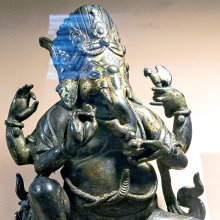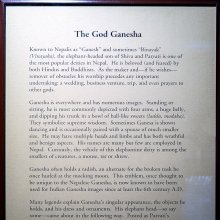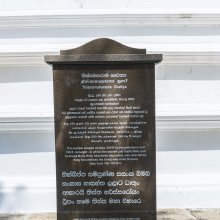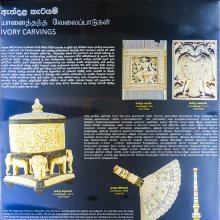Tusk: 1 definition
Introduction:
Tusk means something in Hinduism, Sanskrit. If you want to know the exact meaning, history, etymology or English translation of this term then check out the descriptions on this page. Add your comment or reference to a book if you want to contribute to this summary article.
Images (photo gallery)
In Hinduism
Natyashastra (theatrics and dramaturgy)
Source: Shodhganga: Elements of Art and Architecture in the Trtiyakhanda of the Visnudharmottarapurana (natya)The Tusk (of an elephant) is denoted by the Sanskrit term Danta, whereas Gajadantahasta refers to one of the thirteen Combined-hand Gestures (in Indian Dramas) (known as saṃyuktahastas), according to the Viṣṇudharmottarapurāṇa, an ancient Sanskrit text which (being encyclopedic in nature) deals with a variety of cultural topics such as arts, architecture, music, grammar and astronomy.—The word gajadanta denotes the danta i.e., tusk of gaja i.e., elephant. In the gajadanta posture, both hands in sarpaśīrṣa position are bent towards each other along with the elbows and shoulders and this posture is used to show carrying the mountain.

Natyashastra (नाट्यशास्त्र, nāṭyaśāstra) refers to both the ancient Indian tradition (shastra) of performing arts, (natya—theatrics, drama, dance, music), as well as the name of a Sanskrit work dealing with these subjects. It also teaches the rules for composing Dramatic plays (nataka), construction and performance of Theater, and Poetic works (kavya).
See also (Relevant definitions)
Starts with: Tushkaram, Tushkarmam, Tushkulam, Tuskk.
Query error!
Full-text (+769): Danta, Damshtra, Isadanta, Vishana, Gajadanta, Mahadanta, Rada, Matkuna, Hastidanta, Dadaka, Ranaranka, Radana, Karidanta, Kunja, Damshtrayudha, Damshtrin, Karirika, Damshtrakarala, Sthuloccaya, Vishanin.
Relevant text
Search found 181 books and stories containing Tusk, Tusks; (plurals include: Tusks, Tuskses). You can also click to the full overview containing English textual excerpts. Below are direct links for the most relevant articles:
Brihat Samhita (by N. Chidambaram Iyer)
Chapter 94 - Omens (9): The Attitude of Elephants (hasti-veṣṭita)
Chapter 67 - On the features of the Elephant (hasti-lakṣaṇa)
Matangalila and Hastyayurveda (study) (by Chandrima Das)
Medical treatment of Elephants < [Chapter 3]
Care and keeping of elephants < [Chapter 3]
Ancient trade in Ivory and Elephant-tusks < [Chapter 5]
Amaravati Art in the Context of Andhra Archaeology (by Sreyashi Ray chowdhuri)
Śilvanāga Jātaka < [Chapter 3 - Amarāvatī and the Formative Stage of the Buddhist Art]
Chaddanta Jātaka < [Chapter 3 - Amarāvatī and the Formative Stage of the Buddhist Art]
Jataka tales [English], Volume 1-6 (by Robert Chalmers)
Jataka 72: Sīlavanāga-jātaka < [Book I - Ekanipāta]
Jataka 492: Taccha-Sūkara-jātaka < [Volume 4]
Jataka 283: Vaḍḍhaki-Sūkara-jātaka < [Book III - Tika-Nipāta]
Village Folk-tales of Ceylon (Sri Lanka), vol. 1-3 (by Henry Parker)
Story 251 - How they killed the Great-bellied Tambi < [Part III (b) - Stories of the Western Province and Southern India]
Story 128 - The Magic Lute Player < [Part III - Stories of the Cultivating Caste]
Story 177 - The Female Lark < [Part III - Stories of the Cultivating Caste]
Tiruvaymoli (Thiruvaimozhi): English translation (by S. Satyamurthi Ayyangar)
Pasuram 1.9.2 < [Section 9 - Ninth Tiruvaymoli (Ivaiyum avaiyum)]
Pasuram 4.3.1 < [Section 3 - Third Tiruvaymoli (Kovai Vayal)]
Pasuram 10.10.7 < [Section 10 - Tenth Tiruvaymoli (Muniye! nanmukane!)]



